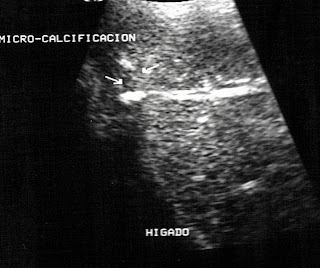Quistes Simples de Mamas
Los quistes de mamas pueden ser benignos o malignos, simples o complejos, tabicados o no tabicados, únicos o múltiples, uni o bilaterales, con grumos o sin grumos en su interior, con paredes lisas o irregulares, con mamelones o sea presencia de áreas que protuyen hacia el interior de la lesión o no.
Hoy mostramos dos casos de lesiones quisticas simples en pacientes femeninas de mama izquierda en paciente de 39 años de edad y lesión quistica proximal en mama derecha de otra paciente. La primera imagen es con transducer linear ( el adecuado para este tipo de exploración y la segunda es con transducer sectorial )
Las exploraciones se hacen dividiendo (teóricamente) la mama en cinco áreas a saber :
Los cuatros cuadrantes clásicos ( CSE-CSI-CIE-CII ) y el área del pezón y la areola mamaria. Regularmente uso la metódica de realizar el estudio primero en mama derecha, estudiando la mama en el sentido horario: Primero el cuadrante superior externo ( CSE ), luego el interno ( CSI ), de ahí paso al cuadrante inferior interno ( CII) y luego el cuadrante Inferior Externo ( CIE ), luego igual en la otra mama , para terminar examinando el pezón y areola de una mama y luego lo mismo en la otra mama. Esta metódica impide que nos descuidemos y que todas las áreas sean examinadas a fondo, sin olvidos.
Los cuatros cuadrantes clásicos ( CSE-CSI-CIE-CII ) y el área del pezón y la areola mamaria. Regularmente uso la metódica de realizar el estudio primero en mama derecha, estudiando la mama en el sentido horario: Primero el cuadrante superior externo ( CSE ), luego el interno ( CSI ), de ahí paso al cuadrante inferior interno ( CII) y luego el cuadrante Inferior Externo ( CIE ), luego igual en la otra mama , para terminar examinando el pezón y areola de una mama y luego lo mismo en la otra mama. Esta metódica impide que nos descuidemos y que todas las áreas sean examinadas a fondo, sin olvidos.
Simple Breast Cysts
Breast cysts can be benign or malignant, simple or complex, septate or non-septate, single or multiple, unilateral or bilateral, with lumps or without lumps inside, with smooth or irregular walls, with mamelons, or the presence of areas that protrude into the lesion or not.
Today we show two cases of simple cystic lesions in female patients of the left breast in a 39-year-old patient and proximal cystic lesion in the right breast of another patient. The first image is with a linear transducer (suitable for this type of exploration and the second is with a sector transducer)
The scans are done by dividing (theoretically) the breast into five areas, namely:
The classic four quadrants (CSE-CSI-CIE-CII) and the area of the nipple and the mammary areola. I regularly use the method of conducting the study first in the right breast, studying the breast in the clockwise direction: First the upper external quadrant (CSE), then the internal (CSI), from there I move to the lower internal quadrant (CII) and then the Lower External Quadrant (CIE), then the same in the other breast, to finish examining the nipple and areola of one breast and then the same in the other breast. This method prevents us from being careless and that all areas are thoroughly examined, without forgetting.
 |
| From MAMAS |
 |
| From MAMAS |


